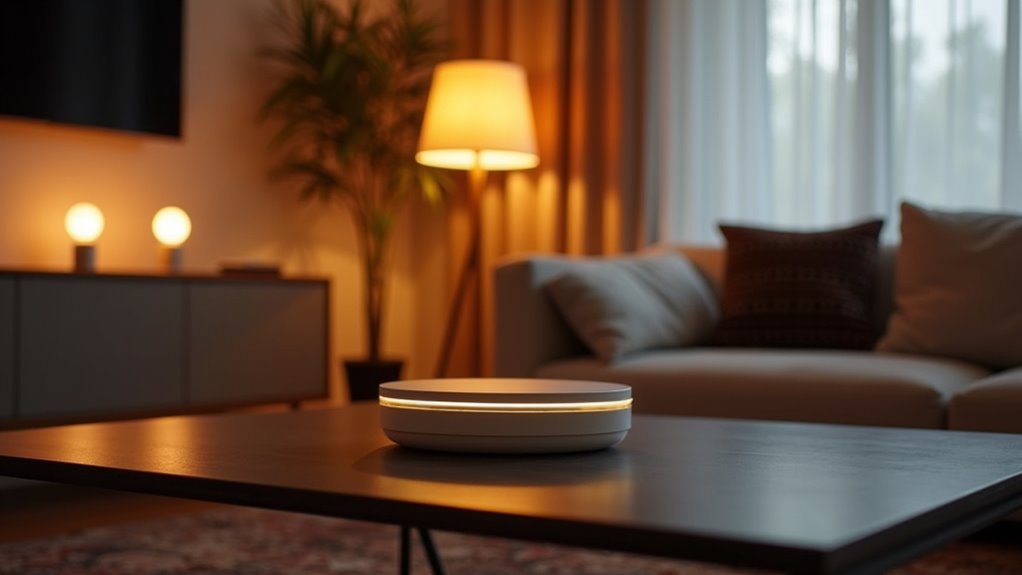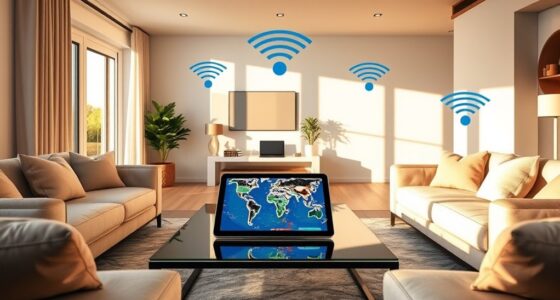Smart home hubs connect your devices, making it easier to control them from one central point. You can choose between multi-protocol hubs, which support various brands, or ecosystem hubs tailored for Alexa, Google Home, and Apple HomeKit. These systems enhance your smart home experience with automation, security, and local control, even during internet outages. There’s much more to explore about setting up and optimizing your smart home for seamless operation and efficiency.
Key Takeaways
- Smart home hubs centralize control of connected devices, enhancing compatibility and operation across various ecosystems like Amazon Alexa, Google Home, and Apple HomeKit.
- Multi-protocol hubs like Homey Pro and Aeotec Smart Home Hub support diverse devices, while ecosystem hubs focus on specific platforms for seamless integration.
- Matter enhances interoperability among devices, allowing users to choose based on features and preferences, promoting a versatile smart home setup.
- Amazon Alexa offers extensive device integration, Google Home excels in natural language processing, and Apple HomeKit prioritizes user privacy and data protection.
- Ecosystem choice significantly impacts user experience, emphasizing the importance of compatibility and integration for efficient smart home operation.
Overview of Smart Home Hubs
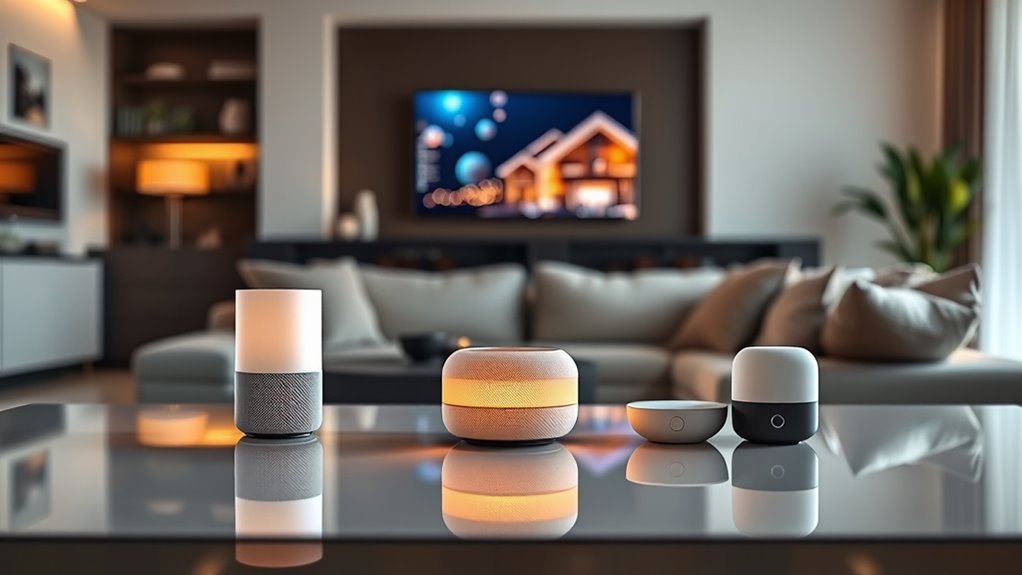
Smart home hubs act as the central command center for your connected devices, allowing you to manage everything from lights to thermostats with just one app.
These hubs play a crucial role in your smart home ecosystem, ensuring device compatibility and smooth operation. They come in two types: multi-protocol hubs that support various standards, like Zigbee and Z-Wave, and ecosystem hubs tied to platforms such as Amazon Alexa. Additionally, advanced technology in smart devices, like energy-efficient models, can enhance your home’s sustainability. With the integration of smart utilities for home, you can further optimize energy usage and comfort levels.
A major benefit of smart home hubs is local control, enabling your devices to function even without an internet connection, enhancing security. Furthermore, just as Tesla utilizes advanced safety features to minimize risks, smart home hubs can improve your home’s security and efficiency.
To achieve interoperability among devices, hubs must act as Matter controllers and Thread border routers, although some protocols may require additional hubs to work seamlessly within your smart home setup.
Types of Smart Home Hubs
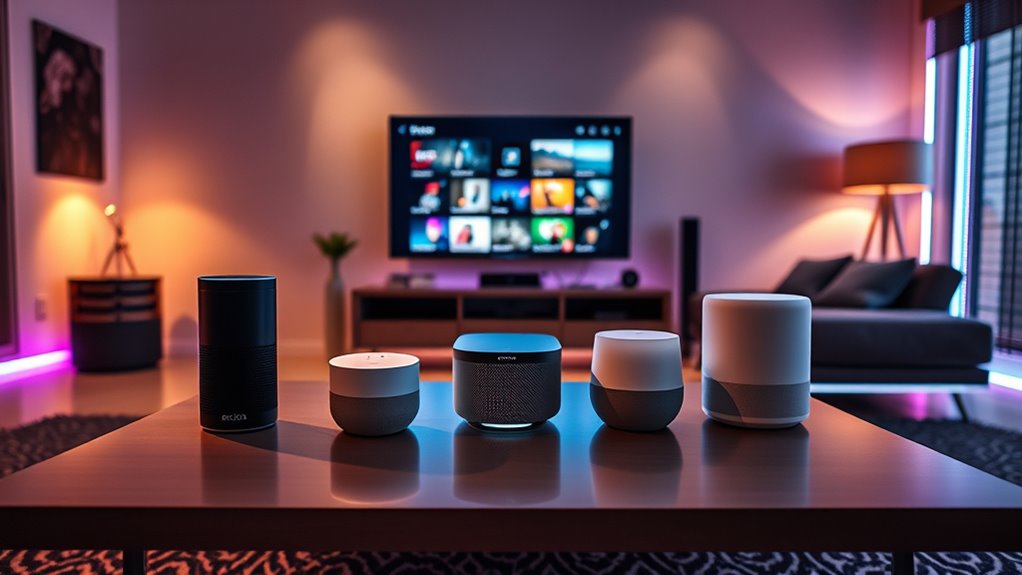
When exploring smart home hubs, you’ll find two main types: multi-protocol hubs and ecosystem hubs.
Multi-protocol hubs offer compatibility with a variety of devices, while ecosystem hubs specialize in optimizing control within specific platforms like Amazon Alexa or Google Home. Understanding these differences helps you choose the right hub for your smart home setup. Additionally, integrating smart technology in areas like bathrooms can enhance convenience and functionality, making your home more efficient. This can be particularly beneficial for managing budgeting goals by allowing you to monitor energy usage and reduce costs. Furthermore, many modern smart devices, including heat pumps, are designed to operate quietly, enhancing your indoor air quality while maintaining a comfortable environment. Moreover, using color accuracy in your device displays can significantly improve the overall visual experience in your smart home.
Multi-Protocol Hubs Overview
Multi-protocol hubs serve as the backbone of modern smart home setups, offering seamless compatibility with a wide array of devices from various manufacturers. These hubs support communication standards like Zigbee, Z-Wave, and Thread, ensuring device compatibility across different brands. By centralizing control of your smart home devices, multi-protocol hubs reduce the need for multiple apps and enhance automation options. Additionally, floral arrangements can be integrated into your smart home for enhanced aesthetic appeal, creating a harmonious living environment. The presence of security systems can greatly enhance the overall safety of your smart home, providing peace of mind alongside convenience.
You’ll enjoy greater flexibility, integrating devices from various ecosystems without being tied to a single platform. Popular examples, like Homey Pro and Aeotec Smart Home Hub, improve user experience through seamless integration. Furthermore, the integration of smart home technology can play a key role in addressing climate change policies, as energy-efficient devices contribute to reducing overall energy consumption. Additionally, features like local control enhance security, keeping your data within the home network and ensuring functionality even during internet outages. Furthermore, investing in a high-performance unit can significantly improve your home’s energy efficiency and comfort, making it a valuable addition to your smart home ecosystem.
Ecosystem Hubs Explained
Ecosystem hubs like Amazon Alexa, Apple HomeKit, and Google Home focus on compatible devices within their platforms. For instance, Alexa supports a wide range of smart home technology, while HomeKit prioritizes security and privacy, often requiring third-party devices to adhere to strict guidelines. These hubs also feature local control, ensuring your devices work even during internet outages. Additionally, the integration of IoT devices enables real-time monitoring of home functions, enhancing overall convenience and efficiency. Furthermore, some of the best lifestyle products can be integrated with these hubs, providing an even better daily routine for users. As the use of smart technology expands, predictive modeling can also help optimize energy consumption by analyzing usage patterns and suggesting efficient practices. Keep in mind that some, like the Apple Home Hub, may need additional hubs for protocols like Zigbee and Z-Wave, which could limit their overall versatility. As the market evolves, these ecosystems are increasingly incorporating NLP technology to improve user interaction and streamline device management.
The Role of Matter in Smart Home Integration
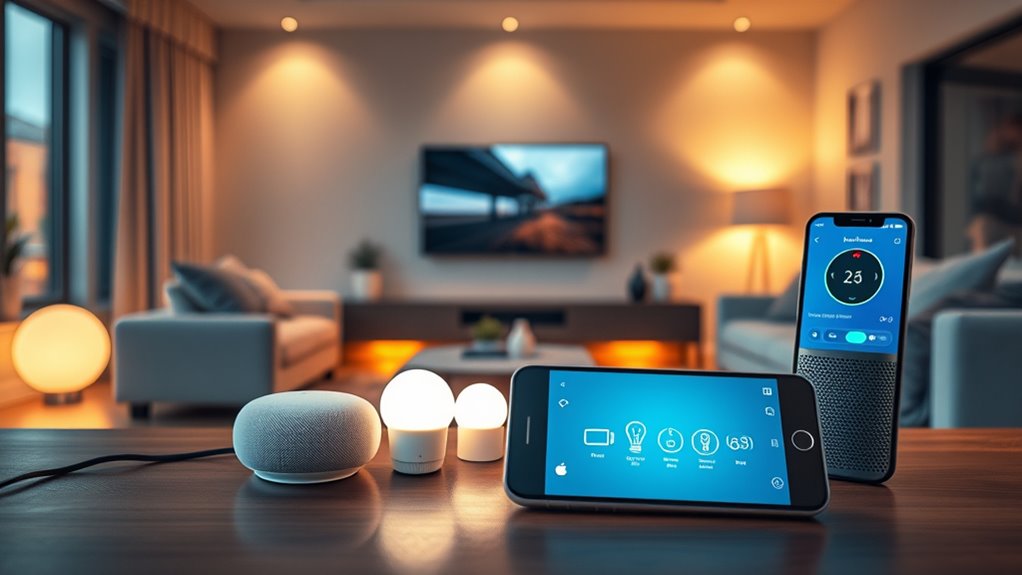
As smart home technology evolves, the introduction of Matter plays a crucial role in enhancing device interoperability across various ecosystems.
With Matter, your smart home hubs can seamlessly manage Matter devices from brands compatible with Amazon Alexa, Google Home, and Apple HomeKit. This standard promotes broader device compatibility, simplifying your integration process.
By utilizing low-powered communication protocols like Thread, Matter improves connectivity and reduces network congestion, creating a more reliable smart home experience.
While Matter supports numerous devices, keep in mind that it doesn’t directly integrate with Zigbee or Z-Wave, so you might need additional hubs for extensive device compatibility.
Ultimately, Matter empowers you to choose devices based on features, enhancing your overall smart home ecosystem experience.
Bridges and Gateways Explained
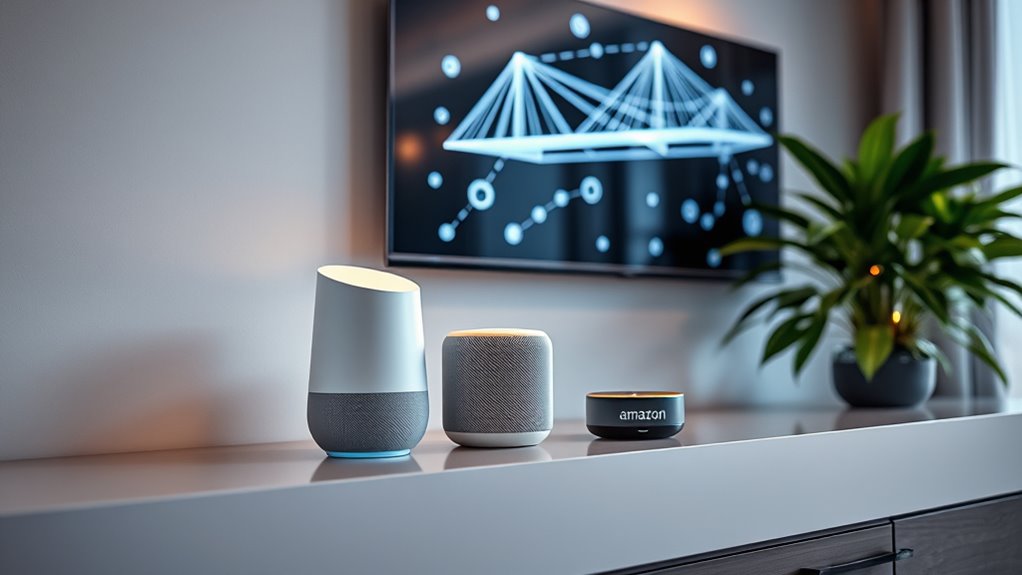
To enhance your smart home experience, understanding bridges and gateways is essential. These specialized devices facilitate communication between smart home devices using different protocols, like Zigbee or Z-Wave, and your main smart home hub.
They act as intermediaries, allowing for seamless integration of various products from different manufacturers, which improves compatibility within your setup. While multi-protocol hubs can communicate with multiple protocols natively, bridges and gateways typically connect to a single protocol. Many manufacturers offer their own bridges or gateways to support specific devices, enabling broader integration when paired with multi-protocol hubs. Additionally, incorporating devices with smart capabilities can further streamline your smart home experience by allowing for remote operation and integration with voice assistants. Understanding how to maintain air purifiers properly can also contribute to a healthier indoor environment within your smart home. Proper maintenance, such as regular filter replacement, ensures optimal performance of air purifiers and enhances air quality in your living space. The importance of regular maintenance extends beyond air purifiers, as it can significantly improve the efficiency of other systems, like heat pumps.
Recommended Multi-Protocol Hubs

When it comes to enhancing your smart home setup, choosing the right multi-protocol hub can make all the difference.
The Homey Pro Hub, priced at $400, stands out by functioning as a Matter controller and Thread border router, ensuring compatibility with major ecosystems like Amazon Alexa, Google Home, and Apple Home. This hub’s integration capabilities are crucial for efficient payment solutions that can streamline transactions in smart devices. Additionally, the ability to centralize control over various devices can significantly improve the overall management of your smart home.
The Homey Pro Hub, at $400, excels as a Matter controller and Thread border router, ensuring seamless compatibility with top ecosystems.
On the more affordable side, the Aeotec Smart Home Hub, at $99, provides an intuitive interface through the SmartThings app, supporting Zigbee, Z-Wave, Thread, Wi-Fi, and BLE for excellent device compatibility.
By opting for these multi-protocol hubs, you can centralize control of various devices, streamline your smart home ecosystem, and enhance automation capabilities. Additionally, integrating these hubs with smart home devices can significantly improve appliance functionality and energy efficiency.
Start with one hub, then expand as needed for a manageable experience.
Best Ecosystem Hubs for Smart Homes

Choosing the best ecosystem hub for your smart home can greatly enhance your automation experience, especially when you consider compatibility and ease of use.
The Homey Pro Hub is a versatile option at $400, supporting multiple protocols and compatible with Amazon Alexa, Google Home, and Apple HomeKit.
If you’re looking for budget-friendly choices, the Aeotec Smart Home Hub at $99 offers local control and works well with various devices.
For Apple HomeKit users, the Apple TV 4K serves as a hub, but you’ll need separate hubs for Zigbee and Z-Wave.
Finally, Amazon’s Echo Hub is great for Alexa users, while Samsung’s SmartThings Station supports multiple protocols but lacks Z-Wave.
Evaluate these options to find your ideal smart hub!
Comparing Smart Home Ecosystems: Alexa, Google Home, Apple HomeKit

When choosing a smart home ecosystem, you’ll want to evaluate compatibility, voice assistant capabilities, and privacy features.
Amazon Alexa leads in device integration, while Google Home shines with its intuitive voice recognition.
On the other hand, Apple HomeKit prioritizes your privacy, though it has fewer compatible devices.
Ecosystem Compatibility and Integration
As you explore the world of smart home ecosystems, understanding the compatibility and integration of devices is essential for creating a seamless experience.
Amazon Alexa leads the pack with the widest range of compatible smart home devices, offering extensive device integration through third-party Skills.
Google Home shines with its natural language processing, allowing for more conversational commands and personalized responses, especially with its multi-user support.
In contrast, Apple HomeKit prioritizes user privacy and security but has a more limited selection of compatible devices, relying on the HomeKit Accessory Protocol.
As different manufacturers support specific platforms, your choice of ecosystem will greatly impact your overall smart home experience and the ease of device integration.
Voice Assistant Capabilities
In the domain of smart home ecosystems, the capabilities of voice assistants play a pivotal role in shaping user experience.
Amazon Alexa offers extensive device compatibility, supporting thousands of smart home products and allowing for customizable voice commands and routines. This versatility makes it a popular choice.
On the other hand, Google Home excels in natural language processing, enabling you to interact in a conversational manner and recognize multiple voices for personalized responses.
While Apple HomeKit prioritizes privacy through the HomeKit Accessory Protocol, its reliance on third-party hardware limits device compatibility.
Privacy and Security Features
While maneuvering through the landscape of smart home ecosystems, understanding the privacy and security features of each option is essential.
Amazon Alexa offers moderate privacy controls, letting you manage voice recordings, but its always-listening feature raises concerns.
Google Home provides strong encryption and privacy management, yet it shares similar worries with its constant listening for voice commands.
In contrast, Apple HomeKit prioritizes your privacy and security by using robust encryption and requiring two-factor authentication. Its limited device compatibility through the HomeKit Accessory Protocol (HAP) enhances security.
As you consider smart devices, weigh the potential privacy risks, such as microphones and cameras, and use available settings to protect your data across all ecosystems.
Key Features of Smart Home Ecosystems
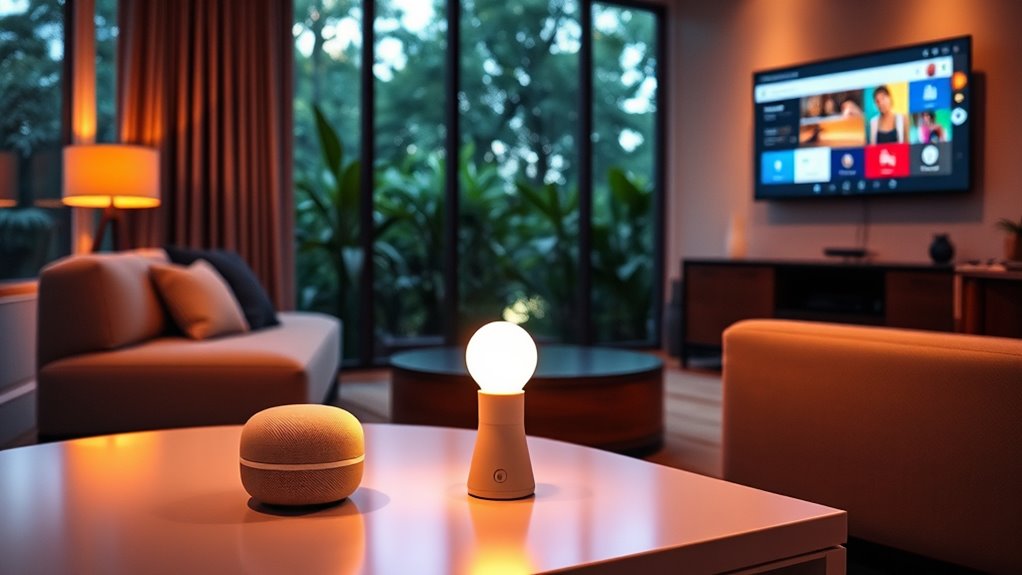
Smart home ecosystems are designed to simplify your life by connecting various smart devices, allowing seamless control and automation.
Amazon Alexa stands out with its extensive device compatibility, supporting thousands of devices and enabling you to enhance functionality through third-party Skills.
Amazon Alexa excels with its broad compatibility, supporting countless devices and enhancing features through third-party Skills.
Google Home excels in natural language processing, making voice commands intuitive and providing personalized responses, especially with multi-user support.
If privacy is your priority, Apple HomeKit offers a closed ecosystem that tightly integrates with Apple devices, guaranteeing robust data protection.
Each of these ecosystems has unique features tailored to different preferences—Alexa for versatility, Google Home for responsiveness, and Apple HomeKit for security.
Keep an eye on compatibility logos to verify your devices operate smoothly within your chosen ecosystem.
Maximizing Your Smart Home Experience
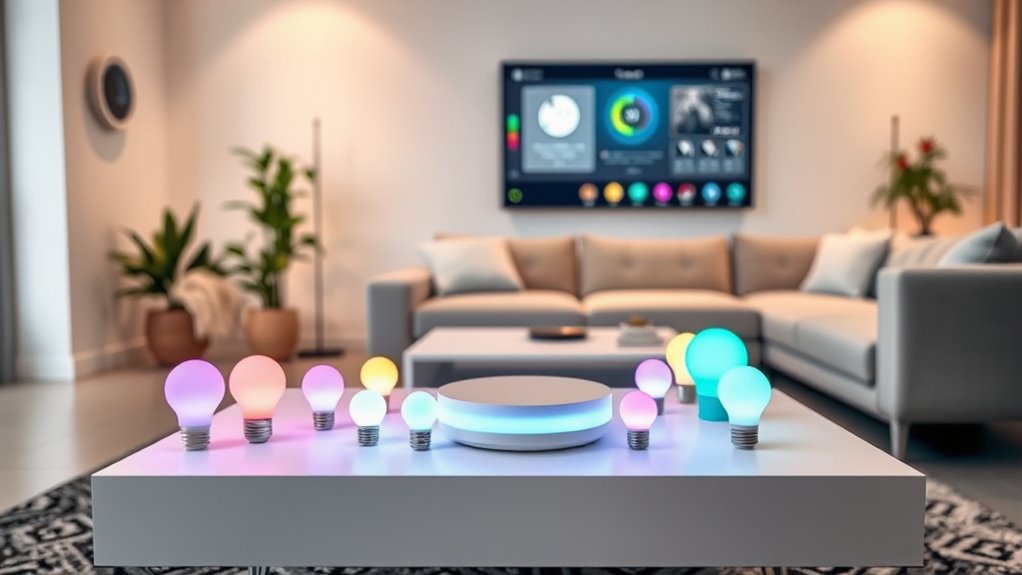
How can you truly elevate your smart home experience? Start by choosing a multi-protocol hub like Homey Pro or Aeotec Smart Home Hub, ensuring compatibility across various devices and protocols like Zigbee and Z-Wave.
Integrate your smart home devices within a single ecosystem, such as Amazon Alexa or Google Home, for seamless control through one app.
Don’t forget to utilize local control features during internet outages, allowing your home automation to function independently.
Take advantage of voice control and automation by setting personalized routines—like scheduling lights to turn on at sunset.
Finally, keep your devices updated with the latest firmware to enhance performance, security, and access new features, maximizing your smart home experience.
Frequently Asked Questions
What Is the Point of a Smart Home Hub?
A smart home hub simplifies your life by acting as the central command for all your smart devices. Instead of juggling multiple apps, you can manage everything from one place, making daily routines smoother.
It enhances compatibility between different brands and protocols, ensuring seamless communication. Plus, with local control, your devices can still operate during internet outages, keeping your home secure and efficient.
Ultimately, a hub streamlines your smart home experience.
What Is the Difference Between Alexa and Homekit?
Think of Alexa as a bustling marketplace, brimming with options, while HomeKit feels like an exclusive boutique.
With Alexa, you’ve got a vast array of compatible devices and a cloud-based system for flexibility. In contrast, HomeKit focuses on security and privacy, requiring Apple devices for access.
While Alexa encourages third-party developers for endless Skills, HomeKit emphasizes a tighter, certified ecosystem, ensuring your data remains secure and under your control.
What Is the Difference Between a Smart Home Gateway and a Hub?
A smart home gateway connects your devices to the internet, often using a single protocol, limiting your options.
In contrast, a smart home hub acts as a central control point, enabling communication across various brands and protocols. This means you can integrate multiple devices into one system, automate them more effectively, and even operate them without internet access.
Conclusion
In the grand symphony of your smart home, the hub serves as the conductor, harmonizing each device into a seamless melody of convenience and control. By choosing the right ecosystem—be it Alexa, Google Home, or Apple HomeKit—you’re not just selecting technology; you’re crafting an experience that transforms your living space into a responsive sanctuary. Embrace the power of integration, and let your home sing in perfect tune with your lifestyle. Your smart home journey awaits!
